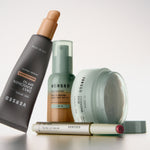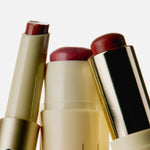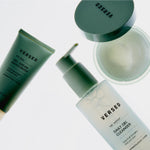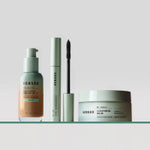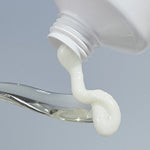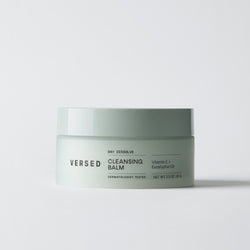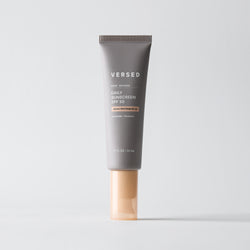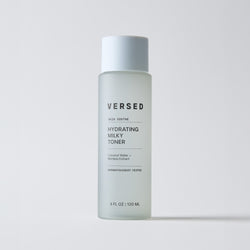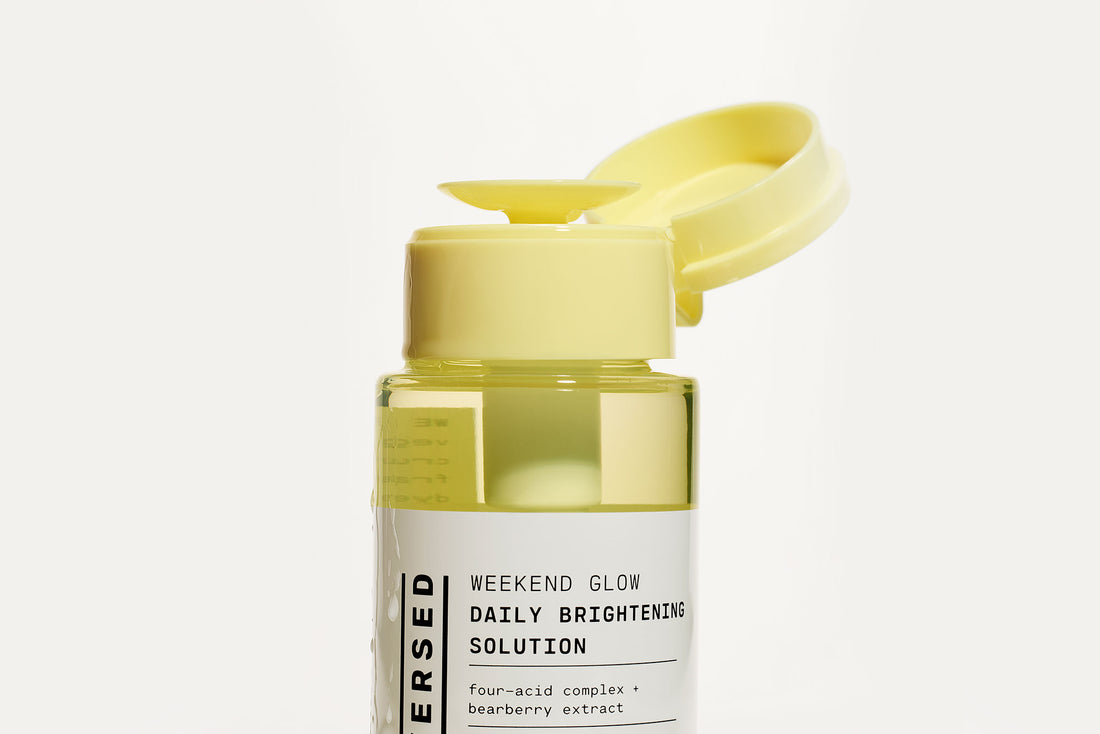Of the 80% of people between 11 and 30 that experience breakouts, 1 in 5 will develop acne scars. As a pimple heals, skin kicks into repair mode to protect itself from future damage. Sounds great and all, except that this recovery can sometimes result in lingering scars and dark spots that are just as frustrating—if not more so–than the breakouts that cause them in the first place.
There are several types of acne scars, ranging from discolored spots to raised lesions. Read our complete guide to acne scars below, including expert advice on how to treat them.
Types of Acne Scars
There are three major categories of acne scars: atrophic, hypertrophic, and post-inflammatory hyperpigmentation (PIH). Something to keep in mind: The root word “trophic” means to stimulate growth. The prefix a- signals a lack of growth, while hyper- insinuates a surplus of it.
Atrophic Scars
Acne that sits deep below the layers of the skin (such as cystic pimples) can result in atrophic scars or depressed sections of the skin. As a breakout heals, our body stimulates the production of collagen to help restore the skin’s barrier. If the body doesn’t produce enough collagen, however, these flat depressions can stick around as atrophic scars. According to board-certified dermatologist Dr. Sam Elmais, there are three types of atrophic scars:Boxcar
As you can imagine, this type of scar has a box-like, square shape. “Boxcar scars are particularly common in places with thicker skin, such as the lower cheekbones and jaw,” says Dr. Elmais. “They are broad depressions with sharply defined edges.”
Rolling
“[These] wave-like depressions appear over otherwise normal-looking skin in a rolling kind of scarring,” says Dr. Elmais. Their depth can vary, too.
Ice Pick
This type of scar can be the most difficult to treat of the three and typically show up on the cheeks. Dr. Elmais explains that “ice pick scars appear to pierce the skin in a small, narrow, deep hole.”
Hypertrophic Scars
Hypertrophic scars, on the other hand, occur when too much collagen is produced during the healing process. “Hypertrophic scars are elevated, hard scars that develop above the skin's surface,” says Dr. Elmais. While it’s most commonly associated with burns, piercings, and injury, it can develop after acne, too.
Keloid Scars
Keloid scars are considered a type of hypertrophic scars with one key distinction. Unlike hypertrophic scars, “keloids are a form of elevated scar that is more severe. They leave a scar that is bigger than the acne that produced them and extends beyond the original spot's edges.”
Post-Inflammatory Hyperpigmentation
The most common acne scar isn’t technically a scar at all. They’re discolored dark spots and marks leftover after a breakout clears known as post-inflammatory hyperpigmentation (PIH). After a skin injury, our hormones trigger the release of melanocytes—cells that produce melanin, the pigment responsible for our skin, eye, and hair color. Why does our body want to produce melanin after an injury? Because melanin helps protect the skin against future damage, mimicking an antioxidant by fending off oxidative stress and keeping the skin’s barrier strong. The downside is that excess melanin produces brown, tan, red, or purple discoloration known as dark spots.
How to Treat Acne Scars
Depending on the type, depth, and severity, some scars can be treated at home while others may require professional help. Of the three types of scars, post-inflammatory hyperpigmentation is the easiest to treat, typically fading away over time with the help of skincare (we talk more about what products to use below). Discoloration from atrophic scars can sometimes be treated at home, but it depends on the severity. You may turn to in-office treatments such as laser therapy, microdermabrasion, microneedling, and chemical peels. Our Instant Resurfacing Mask is a pro-grade facial peel you can try at home, too. It uses a blend of fruit enzymes, AHAs, and BHAs to brighten dark spots and minimize the appearance of pores.Deep atrophic and hypertrophic scars, however, will likely require a surgical procedure. According to Dr. Elmais, there are three common types of scar removal surgery: punch excision (cutting the scar out then stitching it up), punch elevation (removing the scar and raising the remaining tissue), and punch grafting (cutting the scar out and replacing it with skin from another part of the body). Punch excision and elevation can leave a small, nearly invisible scar behind. “Dermal fillers are another solution, [which] are injected into the scar. This method is preferred by many patients, although the results aren’t permanent”.
The Best Ingredients for Fading Acne Scars
Look for these expert-approved ingredients when treating post-breakout discoloration and PIH at home.Vitamin C
This skin-brightening hero inhibits the enzyme tyrosinase that’s responsible for melanin production, reducing dark spots and evening out tone. It also “helps in collagen production, which bridges gaps in the scar,” says Dr. Ahmad Chaudhry M.D. Last but certainly not least, vitamin C is an antioxidant effective at fighting free radicals and preventing skin damage. Infuse skin with a dose of vitamin C by swiping a cotton pad soaked in our Weekend Glow toner after cleansing. It’s gentle enough to use every day so you can consistently treat your acne scars. To amplify its benefits, follow up immediately with its sibling: our Weekend Glow Daily Brightening Moisturizer. It’s formulated with vitamin C, cloudberry seed oil, and a carotenoid complex that shields blue light damage, protects against oxidative stress (which leads to dark spots), and strengthens the barrier.
The “number one ingredient for treating acne scars”, according to dermatologist Dr. Lanzer. Vitamin E conditions the surface of the skin, smoothing out uneven texture (like scars). Pro tip: Pair vitamin C and vitamin E together in your skincare routine using our Daily Brightening Moisturizer. Each ingredient boosts the effectiveness of the other.
Retinol
A vitamin A derivative, retinol speeds up cellular turnover rate (the speed at which darkened skin cells flake off and fresh ones appear) reducing hyperpigmentation. Bonus: Our Gentle Retinol Serum is a great preventative ingredient for acne scars, as it treats existing breakouts while preventing new spots from forming.
Exfoliating acids (Dr. Ahmad specifically recommends lactic acid, while studies also support the benefits of glycolic acid) chemically exfoliate away marks. Smooth on The Shortcut before bedtime; its blend of lactic and glycolic acids will dissolve the bonds between dead skin cells and the surface of the skin, lifting away damage.
How Long Until I See Results?
Everyone’s skin is different; some acne scars may fade easily, while others are permanent. “One of the big reasons dermatologists advise patients to avoid picking or popping their pimples is this increases the inflammatory response, therefore increasing the likelihood of scarring. SO NO POPPING!” says Dr. Chris Tomassian. “Another important step to limit scarring is treating your acne aggressively and early to help prevent breakouts and a chance for potential scarring.” Zinc, formulated in our Clarifying Serum, can be applied daily to help soothe inflammation and prevent future breakouts. While all skin types and tones can deal with scarring, reducing their appearance can be even more difficult for darker complexions as their skin naturally contains more melanin. Because pigmentation occurs deep beneath the layers of the skin, it can take 1-2 months to fade discoloration. Deeper scars, on the other hand, could take years to heal or never fade at all. If you’re struggling to reduce your acne scars, reach out to your dermatologist for help.Stop the damage before it starts by bookmarking our 3-step action plan to treating pimples.
